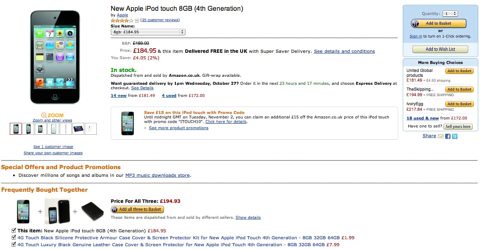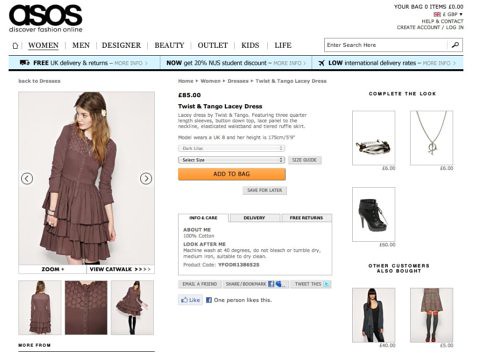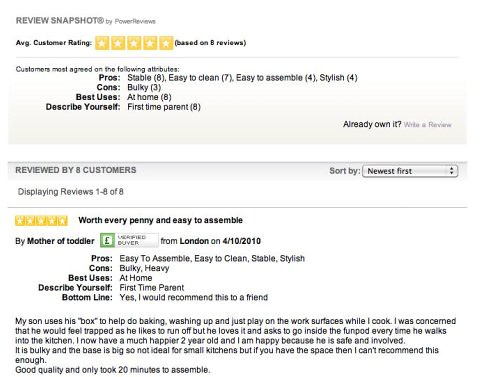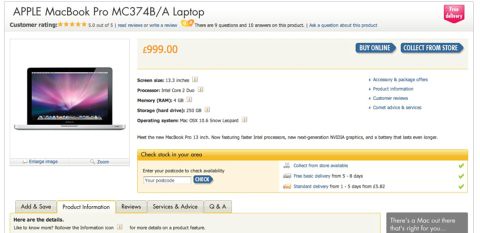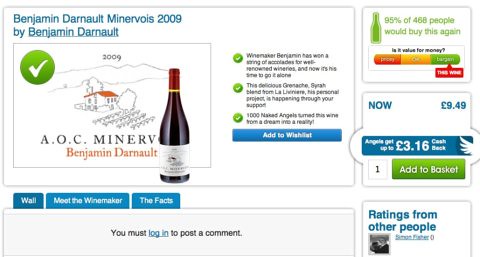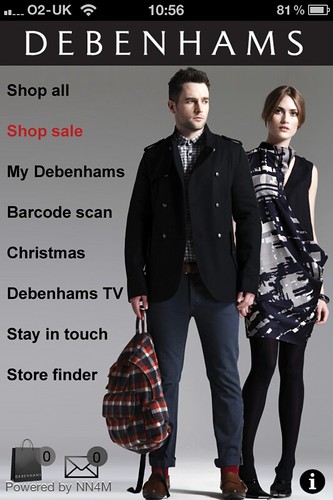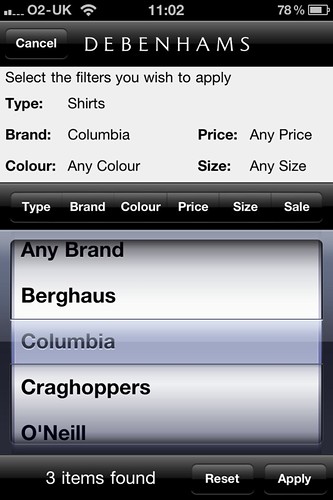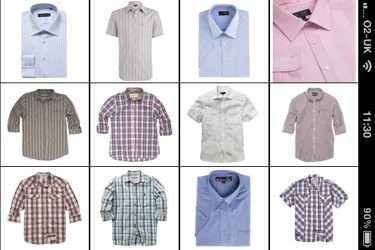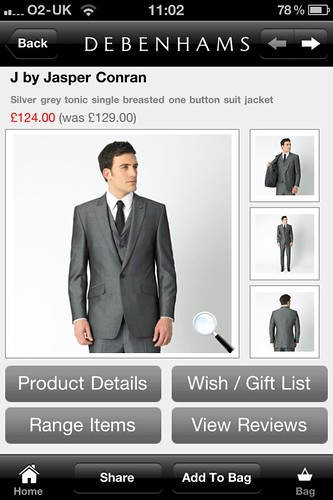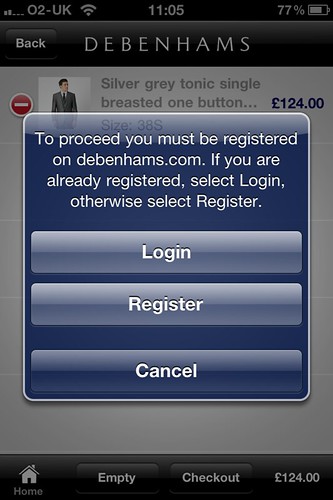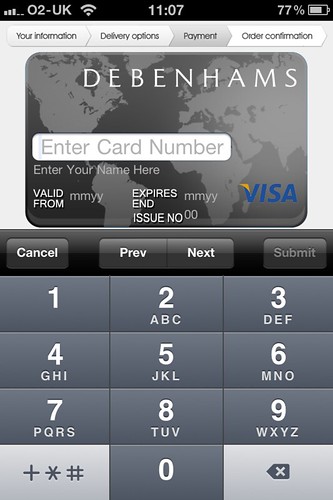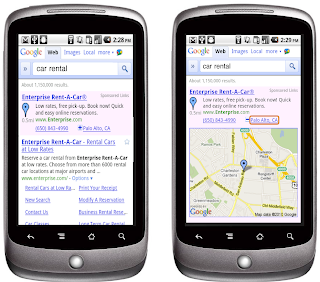| Publicidad en Google /// Salir en Google /// Anuncios en Google /// Anunciarse en Google Not every page in this list is perfect, but they all contain great examples of features that have been used to showcase and sell products, such as great use of video and imagery, presentation of product features, and user reviews. Amazon Amazon's product pages are long and require lots of reading and scrolling (it would take screenshots to show the whole iPod Touch page) to digest the lot, but the pages clearly work well, and contain plenty of innovations that are now commonplace on e-commerce sites.
The most obvious of these innovations is user reviews, but the cross-selling options (customers who bought this also bought...) are also inspired. The pages may be cluttered, but if customers are looking for any information about a product, it's almost certain to be on the page somewhere. SchuhSchuh is a great example of how product images can be used to overcome the fact that customers cannot see product at close hand or try shoes on. One way it does this is through a prominently displayed 'easy 365 day returns' policy, which reassures customers that items can be returned, and the other is through product images. Schuh provides eight images of these trainers so shoppers can see them from every conceivable angle, and there is also the option of a 360° rotating view of the product. FireboxThe product pages of gadget retailer Firebox are almost as cluttered as Amazon's, but they contain just about everything you need to know about the products. I like the use of product videos sent in by customers which show the various gadgets in use. Firebox pays £50 for each video submitted, and this looks to be value for money, as the videos show other shoppers that the product works, and that other customers have bought it without any problems. ASOSASOS gets many things spot on with its product pages. Key information on delivery and returns is provided in a prominent position above the fold, cross-selling is relevant, and a nice big call to action has been placed in the centre of the page. ASOS also does well with product imagery, with several views provided, as well as the option of a catwalk video, which can be quickly viewed without leaving the page or opening a pop-up window. KiddicareKiddicare's product pages are great at conveying everything customers will need to know about a product. Multiple images and videos are provided, handy for showing how to fold and unfold a pram for instance. It also has plenty of product information, while showing both the countdown clock for next day delivery and the number of products left is a good way to create urgency in the customer's mind. What I especially like about Kiddicare's product pages is the presentation of user reviews. Reviews are shown in a lightbox on the page, which saves space, while summarising pros and cons, and best uses of the products is very helpful for shoppers. Hotel ChocolatThe product pages on this site do the basics reasonably well, but are most notable for the quality of product photography. High resolution images of chocolates like this are great for stimulating the taste buds of shoppers. EtsyEtsy provides plenty of information on its product pages, and presents information about sellers in a useful way for shoppers: Customers can see feedback information about the seller at a glance, or can contact them with any questions. I also like to two calls to action have been placed on the page so they can be seen above and below the fold. CometComet does an excellent job of presenting a lot of product information, technical specifications, and useful tools for customers without making its product pages too cluttered.
There is a lot of useful detail here; reviews and a summary of the average score, a summary of product features above the fold, clear delivery information, and even the option to enter a postcode and check stock at your local store. Tabs are used to present the product details, user reviews, buyer's guides and FAQs, which keeps the page at a reasonable size. Nice clear calls to action too. WebtogsThe product pages on this site are a great example of best practice. The page contains plenty of product information and reassurances for customers about delivery, returns etc, while still retaining enough white space to make the page easy to digest. Webtogs uses icons to present key information in a way which stands out, so customers scanning the page can quickly see the dimensions of the tent, the fact that delivery is free, and the big add to basket button. Naked WinesI have included these product pages as they contain a couple of elements which are not used in the previous examples. One is the option to 'meet the winemaker' and get an idea about the story behind the wine. The other is the use of user reviews and ratings to help shoppers make a decision about the wine. The wall underneath the image provides lots of comments from other users about the wine, which can be very useful. The box on the right, which shows the percentage of users that would buy the wine again, and whether it represents value for money or not is a great idea, simply presented. I'm sure there are some other great product pages that I haven't mentioned in this list. Let me know your suggestions below... Jose María Corbí
Oficina: 902 021 130 Móvil: 669 896 673 Skype: josemariacorbi Blog: http://130caracteres.blogspot.com ¡Gratis! Club de links // Publicidad en Google: ¡ofertas!
ATENCIÓN: El contenido de este correo electrónico puede ser confidencial o privilegiado. Si ha recibido este mensaje por error, por favor, no lo reenvíe a nadie. Le rogamos que borre todas las copias y mensajes adjuntos y por favor comuníquenos que lo ha recibido la persona equivocada. Muchas gracias ¡Calidad y Eficiencia Para Su Publicidad En Internet! |
Publicidad en Google: 10 ejemplos de páginas de comercio electrónico
Publicidad en Google: Un ejemplo de estrategia móvil concretada en una aplicación de iphone
| Publicidad en Google /// Salir en Google /// Anuncios en Google /// Anunciarse en Google While M&S and John Lewis went for mobile websites, Debenhams released a mobile commerce app for iPhone last week, thanks to the volume of visits to the main site from iPhone users. The app also features a barcode scanner, the first used by a high street retailer, which should make the app useful for researching products and prices offline. NavigationThe homepage of the app contains links to the various sections of the app, from the shopping options to the barcode scanner and store finder tools. Once you have selected a shopping option, you can select from the various sub-categories: There are enough categories and sub-categories to enable customers to browse the app down to a more manageable number of products, at which point customers can then narrow their selection by brand, price, size and colour: There is also the option of viewing in landscape mode, and browsing through images of products: Product pagesOne thing that this does well in comparison to other mobile commerce sites and apps does well is product images. For most products on the app a choice of three or four images is provided, all of which can be enlarged. So, in the image below, customers can see what the lining of the suit looks like: There are obvious limitations with product images on mobile sites and apps, but by providing multiple photos, Debenhams allows customers to get a far better idea of how the clothes will look. The product pages provide further details and reviews via links on the page, though one major omission is delivery charges / timescales and the returns policy. This information can be key to purchase decisions, and so should be available on or via the product page. There is a small link to returns policies, delivery charges and other information on the homepage on the app, but this isn't so easy to spot. A more prominent link available on each page of the app would be a better idea. Checkout processThe checkout process has been designed specifically for mobile, though making new customers register before entering the process is a mistake: Registration can be a barrier to purchase on standard e-commerce sites, but on a mobile where data entry can be fiddly, it really should be avoided to reduce abandonment. Once you have registered, and head for the checkout, you get this page for shoppers to enter a voucher code: I'm not sure that giving such prominence to discount codes within a mobile app is wise, since many customers will not have a code and may feel they are missing out on a bargain, or may even be prompted to leave the checkout to look for codes. On a desktop site, at least users can do this in a new tab and remain within the checkout, but on an app, they will have to leave the process altogether. A less prominent position for the code entry box may be a better idea. These issues aside, the mobile checkout on the app has been very well designed. The amount on data entry required and the number of steps has been kept to a minimum, while there are some nice touches, such as this payment screen: By showing the image of a credit card, the app neatly deals with any questions about the information required, and flips over to the back to prompt customers to enter the three digit CVV code. Multichannel featuresThe app has a prominent and very usable store finder, which detect your location and serves up the four nearest stores. Details of opening hours, store facilities, and directions are all available, as well as a link to call the store. Debenhams has also added a barcode reader to the app, making it a very useful tool for offline shopping. The scanner can be used to compare prices of products in the Debenhams range, and the retailer also plans to add QR codes to its advertising and Debenhams' store windows which will allow users of the app to access exclusive offers. One thing the app doesn't have (so far at least) is check and reserve, which would have given users another option for purchasing products. ConclusionA few tweaks here and there would improve the app, such as providing more prominent delivery information and finding an alternative to registration to reduce the potential for checkout abandonment. This is a well designed and generally usable app. While some retailers have opted for the mobile web over apps, Debenhams does at least justify the app by adding features such as wishlists and barcode scanners. Jose María Corbí
Oficina: 902 021 130 Móvil: 669 896 673 Skype: josemariacorbi Blog: http://130caracteres.blogspot.com ¡Gratis! Club de links // Publicidad en Google: ¡ofertas!
ATENCIÓN: El contenido de este correo electrónico puede ser confidencial o privilegiado. Si ha recibido este mensaje por error, por favor, no lo reenvíe a nadie. Le rogamos que borre todas las copias y mensajes adjuntos y por favor comuníquenos que lo ha recibido la persona equivocada. Muchas gracias ¡Calidad y Eficiencia Para Su Publicidad En Internet! |
Publicidad en Google: Más capacidad para la Red de Display (contenido) de Google
Publicidad en Google /// Salir en Google /// Anuncios en Google /// Anunciarse en Google One of our key goals is to help you drive better performance with your display advertising campaigns. As users increasingly spend time across a growing number of sites, however, display advertising is becoming more challenging. Last year alone there were 47 million new web sites created*. Contextual targeting can help by automatically showing your ad to users on web pages related to your products on the millions of sites in the Google Display Network (GDN). But building and managing your campaigns can still be time-consuming. So how do you reach your target audience easily and efficiently while meeting your business goals? Today, we're launching two tools -- the Display Campaign Optimizer and the Contextual Targeting Tool -- to help you maximize your performance on the GDN, while saving you valuable time and resources. Display Campaign Optimizer. This new tool automatically manages targeting and bidding for your Display Network campaigns with the goal of increasing your conversions while meeting your advertising objectives. You simply provide us with your target cost-per-acquisition (CPA), creatives and budget, and the Display Campaign Optimizer goes to work, showing your ads in all the right places, automatically. It monitors your campaign performance and, in real time, adjusts your campaign accordingly. Your campaigns stay optimized, as it "learns" and does more of what's working and less of what isn't. For example, Seventh Generation, a company that sells eco-friendly household cleaning, baby care and personal care products, was looking to connect with more "green" consumers across the web and get them to download coupons from their site for use in-store. After implementing the Display Campaign Optimizer, the tool delivered 60% of the coupons downloaded from their site, with a CPA 20% below their target. Further, analysis of our beta testers showed that on average, campaign using Display Campaign Optimizer were likely responsible for almost one-third of the accounts' total conversion volume with CPAs within 6% of their peer group CPA.** The Display Campaign Optimizer is now available globally for larger campaigns running on the Google Display Network. Contextual Targeting Tool. While the Display Campaign Optimizer is an automated solution that does all the heavy lifting on your behalf, the Contextual Targeting Tool helps you more efficiently build your own display campaigns. This tool is ideal for those of you who prefer transparency and control over your campaigns' targeting and bidding. The Contextual Targeting Tool builds tightly themed keyword lists for your display campaigns, which are used to contextually target your ads. Tightly themed keyword lists are the basis of effective contextual targeting. With this tool, you can build dozens, even hundreds, of ad groups in minutes, quickly scaling your campaign performance while ensuring accurate targeting and control over your campaign. For example, if you sell yoga gear, normally, you might take the time to build out separate ad groups around each of your product lines, such as yoga mats, yoga clothing, yoga gear, etc. Inputting each product category into the Contextual Targeting Tool will generate even more tightly themed keyword lists. For example, inputting 'yoga mats' into the tool generates more specific ad groups, such as designer yoga mats, thick yoga mats, yoga mats with designs, etc. These are all separate ad groups that can help you generate additional traffic and sales, that you wouldn't necessarily think of creating when manually building out your campaigns. This week, we're beginning a phased launch of the Contextual Targeting Tool, and it will become available to more advertisers over the coming weeks and months. Whether you're looking for easier ways of building out your display campaigns or looking for a more robust, automated solution that continually optimizes bids and targeting, we think these tools will help you easily and efficiently achieve performance at scale with your display campaigns. Posted by Woojin Kim, Product Manager and Shaun Seo, Product Manager * Source: Netcraft Web Server Survey, Dec. 2009 ** Source: Internal analysis of active beta testers, in comparison with peer group advertisers. Oct. 2010 Jose María Corbí Oficina: 902 021 130 Móvil: 669 896 673 Skype: josemariacorbi ATENCIÓN: El contenido de este correo electrónico puede ser confidencial o privilegiado. Si ha recibido este mensaje por error, por favor, no lo reenvíe a nadie. Le rogamos que borre todas las copias y mensajes adjuntos y por favor comuníquenos que lo ha recibido la persona equivocada. Muchas gracias ¡Calidad y Eficiencia Para Su Publicidad En Internet! |
Publicidad en Google: Más sobre Google Instant
| Publicidad en Google // Salir en Google // Anunciarse en Google // Anuncios en Google Posted 08 October 2010 14:46pm by Will Critchlow with 9 comments Sam Crocker, one of our lead SEOs in London has been researching what proportion of searchers are seeing Google Instant. This has a potentially significant impact on the various research being published on how Instant affects average query length. Here's what he has found: There has been a great deal written about Google Instant since its release and some very interesting studies about the impact of Instant on search behaviour. These studies have analysed the number of keyphrases of a certain length, the average length of searches, and even gone so far as to point out that the overall impact of Google Instant has been smaller than the impact of the average update to the Google algorithm in terms of search traffic and the length of keywords. Whilst we can glean some information from this data I want to be very careful to point out that we should not be too hasty. The most important point to make about the referenced studies is: none of these studies claim to have segmented out the data from just Instant traffic. If this is the case, any implications of Instant's impact on search behaviour does not accurately measure the impact of Instant, but rather the observed change on overall traffic driven by search since Instant has been released - and this differentiation is absolutely essential. When Google updates its algorithm it impacts everyone but usually will not change user behaviour or experience in any drastic way. However, changing the "Google" experience as significantly as Google has done with Instant- has the potential to change the way we search, rather than SEO performance and this is extremely important to bear in mind. There is a difference between search behaviour and performance of a website in the search engines. Search behaviour refers specifically to the way people search, whereas performance in the search engines refers more generally to how the search engines rank particular sites for a given word. Looking simply at "before" and "after" Instant results in analytics does not accurately account for the potential impact of a change in the user experience of this magnitude. We have taken a stab (given the data available to us) at segmenting the data and analyzing the true impact of Instant on searchers behaviour, rather than the broader impact on search volume and changes in analytics data pre/post the introduction of Google Instant. And, as you may have gathered from above, our results look very different than some of the other studies out there. Our study is by no means perfect science. However, we are hopeful that it will push Google to share a bit more with Analytics users and that others will run these numbers across their own data but the results we did find would certainly indicate that the prediction of many about the increased importance of the long tail may actually still be valid (see Ian Lurie on Read Write Web). What's the Difference?
Meanwhile, in a post by Essential Travel, their team looked at a number of users and ran them through a handful of tests. In their tests- relying specifically on users interacting with Instant- they point out that about 85% of their test subjects typed out the full phrase for which they were searching rather than let Instant work its magic. This study was cause for some debate in our own offices as to whether or not a user hitting enter after conducting a search really counted as using Instant at all. Whilst neither of these posts really "prove" anything, they are indicative of some of the data we, here at Distilled have looked at in our own log files. After reading some of these posts (particularly the ones that suggested that Instant has had little impact on the length of search queries) I thought it would be interesting to take a look at the log files for our servers. I admit that this data is by no means statistically significant (it's a small sample size for one website generally tailored towards people who are active in online marketing and thus are fairly savvy), but it certainly is reflective of the fact that the true impact of Instant is probably being grossly underestimated. Our Evidence & Our Findings
Perhaps the first thing that jumped out at us is the fact that only 5% of our visits could be traced back to Google Instant with any level of confidence. Although we have yet to find any explicit confirmation our analysis suggests that the addition of "sqi=2" and/or "sclient=psy" and our findings are based upon the referrer query string containing one or both of these elements. I am happy to concede that this is not a statistically significant study, though it echoes some of our original concerns:
Every study we have looked at until now has argued strongly that "Instant doesn't really change anything" which is true when considering the impact of Instant on all search traffic. However, the caveat to having any significance is that Instant continues to be shown only to a small percentage of searchers (which in fairness has been pointed out in some of the other studies we've referenced). Google Instant may not change much in the way of trends for "all search traffic" though the suggestion that it can tip the scales at all is indicative of the fact that we're not giving it full credit (have another look at the first graph). Extrapolating on the data and segmenting by whether the user came to the site by way of Instant we saw: So what would this mean if everyone were using Instant (i.e. the actual impact of Instant on search behaviour) versus the length of queries of all searches over this period:
This lends some traction to the idea that the true impact of Google Instant on searchers behaviour has likely been grossly underestimated. The net effect (at the moment) may be rather small, but the potential impact should Instant ever become the norm is massive. And suggestions that Google Instant has not had any noticeable impact on long-tail search should be challenged as the product is rolled out to a larger audience. Perhaps the above chart is the most helpful in illustrating the potential impact of Google Instant as compared to the current state (e.g. some users with Google Instant, some coming by way of the toolbar and some by way of "traditional" Google) or the "Percentage all natural" case where no search would be coming by way of Instant. The comparison of the Red and Blue data points suggest that perhaps there has not been a very big change. This is consistent with these other studies' findings in large part because it discounts for the fact that such a small minority is actually using Google Instant. The case in green in the above chart is unlikely to ever occur (if for no other reason than the fact that people may always prefer use the toolbar for search and so on), however it is important to illustrate the problems with the conclusion that Instant has not changed anything. The indications from this (admittedly too small) dataset are that Google Instant may yet be a "game changer" in the search marketing community. What should I do!? The answer is not to panic, and to keep your eye on this. At the moment, it would appear as though Instant is only impacting a limited number of searchers. We wouldn't want you to change your approach drastically as a result of this research but we do want to challenge the mantra that "Google Instant hasn't changed anything". We should probably be paying more attention to the uptake of this new product (5% is a shockingly small percentage) much more so than its implications on analytics when so few people are using Instant at present... and we should definitely keep testing. So far the impact may have been fairly negligible but the value of the longtail could very well increase if rollout does. Google Instant almost certainly has changed search behaviour for those using it- the ultimate unknown is just how many people this is ultimately going to impact and how many people end up using Instant search. Jose María Corbí
Oficina: 902 021 130 Móvil: 669 896 673 Skype: josemariacorbi Blog: http://130caracteres.blogspot.com ¡Gratis! Club de links // Publicidad en Google: ¡ofertas!
ATENCIÓN: El contenido de este correo electrónico puede ser confidencial o privilegiado. Si ha recibido este mensaje por error, por favor, no lo reenvíe a nadie. Le rogamos que borre todas las copias y mensajes adjuntos y por favor comuníquenos que lo ha recibido la persona equivocada. Muchas gracias ¡Calidad y Eficiencia Para Su Publicidad En Internet! |
Publicidad en Google: AdSitelinks Para Anuncios Móviles
Publicidad en Google // Anuncios en Google // Anunciarse en Google // Salir en GoogleFind information faster with mobile Ad Sitelinks |
 |
| click to enlarge image |
Since we're constantly working to bring our experience with desktop advertising to the mobile web, starting with Ad Sitelinks is simple. If you've enabled Ad Sitelinks on desktop, your ads will automatically show on mobile phones -- provided your campaigns are opted-in to run on iPhone and other mobile devices with full Internet browsers.
To learn more about Mobile Ad Sitelinks, please visit the AdWords Help Center.
Posted by Chrix Finne, Google Mobile Ads Product Manager
ATENCIÓN: El contenido de este correo electrónico puede ser confidencial o privilegiado. Si ha recibido este mensaje por error, por favor, no lo reenvíe a nadie. Le rogamos que borre todas las copias y mensajes adjuntos y por favor comuníquenos que lo ha recibido la persona equivocada. Muchas gracias
¡Calidad y Eficiencia Para Su Publicidad En Internet!
Publicidad en Google: Movers and Shakers: Claire Hughes Johnson, Vice President, Global Online Sales, Google
Publicidad En Google: Recortes de Prensa del último seminario de Jose María Corbí y 130Caracteres
Publicidad en Google: Hiperlocalismo, otra demostración de grandeza de Google Adwords.
| Publicidad en Google // Salir en Google // Anuncios en Google // Anunciarse en Google No era suficiente con mostrar millones de resultados en décimas de segundo... y vino Google Instant, resultados predictivos, "te mostramos los resultados antes de que finalices tu búsqueda". No era suficiente con mostrar anuncios locales, es decir, si buscas pizzerías en Valencia, mostramos anuncios de publicidad en Google de pizzerías en Valencia incluyendo mapa para llegar a la pizzería... y ahora lanzan los anuncios "hiperlocales" en los que además de mostrarte anuncios locales te dicen en tu teléfono móvil la distancia a la que se encuentran las empresas que ofrecen los productos o servicios que buscas. ¡¡Google Grande!! Imagine driving to work and your Check Engine light comes on. After pulling over and calling a tow truck, you realize you'll need another car to get to work and use while yours is getting repaired. You pull out your phone and search for "car rental," hoping that you can find one nearby. From a Google search ad result you discover there's an Enterprise Rent-A-Car neighborhood location just half a mile away! The blue distance marker made it easy to see that Enterprise is approximately .5 miles away. You click on the phone number listed in the ad and are instantly connected with the car rental service. Soon, an Enterprise representative is on his way to pick you up.
Hyperlocal distance information enhances the location extensions ad format with a marker providing the distance between the user and your business location. This visual cue instantly helps customers who are on the go and close to a point of sale know that your business is nearby which can drive more traffic to your store and generate more revenue for your business. Users see the hyperlocal ads only if they've opted into sharing their location on Google.com. And because the hyperlocal distance feature is built on top of location extensions, users can also easily click to see where your business is located on a map and click to call and connect with your business immediately. Hyperlocal distance information is automatically enabled for location extensions and does not require any additional configurations, allowing you to effortlessly perform hyperlocal advertising with your existing location extensions. Campaigns must also be opted into showing on iPhones, Android OS phones or other mobile devices with full Internet browsers. The ad format is available only on the Google search network and in countries supporting location extensions ad formats. Advertisers are only charged when users click to visit the website or on the phone number shown in the ad. Google is committed to expanding the possibilities of mobile local advertising by developing innovative hyperlocal ad features powered by robust location-based ad serving. Stay tuned for more exciting developments in hyperlocal advertising from the Google Mobile Ads team. Posted by Surojit Chatterjee, Google Mobile Ads Product Manager Jose María Corbí
Oficina: 902 021 130 Móvil: 669 896 673 Skype: josemariacorbi Blog: http://130caracteres.blogspot.com ¡Gratis! Club de links // Publicidad en Google: ¡ofertas!
ATENCIÓN: El contenido de este correo electrónico puede ser confidencial o privilegiado. Si ha recibido este mensaje por error, por favor, no lo reenvíe a nadie. Le rogamos que borre todas las copias y mensajes adjuntos y por favor comuníquenos que lo ha recibido la persona equivocada. Muchas gracias ¡Calidad y Eficiencia Para Su Publicidad En Internet! |
Publicidad en Google: Con Adwords la publicidad online multilingue es un hecho: mira un ejemplo
| Publicidad en Google // Salir en Google // Anuncios en Google // Anunciarse en Google Cristina is a person who interacts with media all day long. In the morning, she browses beauty sites before biking to work. Over lunch, she reads a Colombian newspaper to check in on the results of the presidential elections, and then texts her friend about dinner plans from her iPhone. She searches for restaurant recommendations, meets her friends at the restaurant, and finally goes home to watch her favorite telenovelas. Connected with technology and her culture, Cristina is a modern Latina, proud of being Hispanic and American at the same time. Why should marketers care about Cristina, and others like her? Hispanics are the fastest growing US population, and their buying power is projected to reach $1.4T by 20131. Hispanics are also coming online extremely quickly: the total time Hispanics spent online grew by 6.9% in 20092, 3.9 times faster than the general market rate. To connect with Hispanics like Cristina online, it's important to understand a few key myths about the market. Myth #1: I need to have a Spanish-language website in order to market to Hispanics. While 22% of Hispanics speak only Spanish and another third prefer it, most US Hispanics are comfortable with English3 and feel that English sites are more comprehensive4. While a Spanish-language website can be an asset, it won't make or break the success of your campaign so long as you think carefully about your message and present a compelling value proposition on your site. Myth #2: The return on investment from Hispanic marketing isn't big enough. Hispanic advertising campaigns are often more cost-effective than main-market campaigns. Online CPCs and CPMs tend to be much cheaper due to low competition, and Hispanics are actually more likely than their general market counterparts to take action based on search and banner ads5. Moreover, over half of online Hispanics complete a purchase at least once a month6, so direct response marketers can engage as deeply as brand builders can. Myth #3: My general market campaign covers the Hispanic market. Hispanics may be comfortable with English content, but marketers are missing the opportunity to win Hispanics' loyalty if they use their general market campaign as a catch-all. Hispanics value their identity, and 66% of US Hispanics appreciate being marketed to in a culturally relevant way7. A recent campaign by Ford demonstrated how bilingual marketing can improve sales: Ford's marketing team doubled the incremental lift of their English creative when they rolled out dual-language, culturally relevant creative8 in a recent direct mail campaign. Interested in learning more about Hispanics in the US? Email multicultural@google.com to stay in touch, and keep an eye out for fresh primary research in Q4 and Q1. Posted by Meghan Sherlock, US Hispanic Specialist [1] Selig Center for Economic Growth, Terry College of Business, The University of Georgia. "The Multicultural Economy 2008." January 2009. [2] Comscore, April 2009. "U.S. Hispanic Internet Audience Growth Outpaces Total U.S. Online Population by 50 Percent." [3] Juan Tornoe. "Hispanic Marketing Is Not Spanish Marketing." http://nglc.biz/2010/07/22/hispanic-marketing-is-not-spanish-marketing/. July 2010. http://advertising.aol.com/sites/default/files/webfm/research/HispanicCyberStudy-2010.pdf. [4] AOL Hispanic Cyberstudy. 2010. [5] "Search ads": ARAnet Adfusion survey conducted by Opinion Research Corporation, provided by eMarketer, March 16 2009. "Banner ads": eMarketer. "US Internet Users Likely to Read And Take Action After Viewing Banner Ads, by Race/Ethnicity." June 2009. [6] RTO Online, Hispanic Internet Usage Report, February 2009. [7] Alvaro Cabrera, Executive Director of Integration at Diest, Inc. June 25, 2009. "10 Things You Should Know About US Hispanics." http://juantornoe.blogs.com/hispanictrending/2009/06/10-things-you-should-know-about-us-hispanics.html. [8] Deliver Magazine. August 2010. "Talk, Don't Translate." Jose María Corbí
Oficina: 902 021 130 Móvil: 669 896 673 Skype: josemariacorbi Blog: http://130caracteres.blogspot.com ¡Gratis! Club de links // Publicidad en Google: ¡ofertas!
ATENCIÓN: El contenido de este correo electrónico puede ser confidencial o privilegiado. Si ha recibido este mensaje por error, por favor, no lo reenvíe a nadie. Le rogamos que borre todas las copias y mensajes adjuntos y por favor comuníquenos que lo ha recibido la persona equivocada. Muchas gracias ¡Calidad y Eficiencia Para Su Publicidad En Internet! |
Nuestro periódico
Preguntas Básicas Sobre Publicidad En Google
Entradas populares
-
Estupendo artículo de Leena Rao en TechCrunch. White label daily deals platform and TC Disrupt finalist ChompOn is releasing some inter...
-
RT @SEOmoz: 40 Important Local Search Questions Answered by @niftymarketing – New post! http://flip.it/w3PDF [green_message]Source: http://f...
-
27 things I need to see on an e-commerce homepage Posted 10 January 2011 13:05pm by Graham Charlton A retailer's homepage ...
-
Comparte las cuentas de Twitter y/o Facebook con expertos de los que te fias. Es para un libro que estoy escribiendo. Muchas gracias!!! [gre...
-
Publicidad en Google /// Salir en Google /// Anuncios en Google /// Anunciarse en Google The five clients you should avoid like t...

